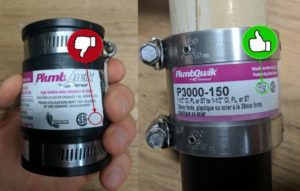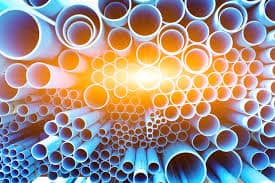Acrylonitrile Butadiene Styrene (ABS) and Poly Vinyl Chloride (PVC) pipes are both plastic, but other differences can determine which to use for the average San Diego homeowner.
Plastic pipes are used in all kinds of plumbing applications. They are inexpensive, lightweight and will almost never corrode under normal conditions. They maintain temperatures of water, keeping hot water hot. And they prevent condensation build-up from cold water, unlike what happens with many kinds of metal pipe. But there are differences between the two main kinds of leading types of plastic pipes — ABS and PVC.
When Would You See ABS and PVC in the Same Plumbing System?
A prime example of when you might need to connect ABS to PVS is when ABS is used for the drain inside of a home or business, connecting to a PVC drain system outside the building Or it might be reversed, with the PVC drain inside and the ABS outside.
Both PVC and ABS pipes have characteristics that safeguard them from most kinds of acids, alkalis and salt-based materials. Both of these plastics, however, are not impenetrable to aromatic and chlorinated hydrocarbons. Either of these kinds of piping can be specified above or below ground, but ABS is more susceptible to deformation damage when exposed to the sun. Since this can occur, some local regulators require ABS pipes to include pigments to guard it from UV radiation, or to be coated with latex paint.
ABS piping can be easier for installation than PVC pipes, since PVC pipes require a purple primer where each joint is glued together. The joints must then be joined together for 5 to 10 seconds before the glue can do its work.
ABS and PVC Use in Construction and Other Applications Beyond Plumbing
The often larger diameter ABS is used most commonly in drain/waste and venting systems; and sewers. ABS is also employed for electrical insulation. PVC is similarly used for drain/waste and venting systems; and for other electrical applications such as insulation on electrical lines.

Legos are made of ABS plastic
PVC is also found in non-plumbing products, including toys and clothes – in particular for leather-like or waterproofing capabilities; automotive interiors, flooring, and many other consumer oriented plastic applications.
Which one is Stronger, ABS or PVC?
At lower temperatures, ABS is rated higher for impact strength than PVC. But ABS can deform under sun exposure, which is why it is more commonly found in underground applications.
PVC is less durable, since it was created to be more flexible and softer than most other plastics. but ABS is stronger and more shock resistant. PVC is considered more effective at muffling the sound of running water, a potentially important consideration if pipes are going to be in walls close to sleeping areas.
How to Connect a PVC Pipe to ABS Pipe
When presented with joining PVC to ABS piping, don’t make the assumption that you can simply glue them together. The proper way to connect PVC to ABS plastic pipes is by using special transition fittings, properly specified for the size of the pipes. These fittings ensure a solid joint and are in line with standard plumbing codes.

The right and wrong kinds of ABS to PVC connectors
What about ABS to PVC Cement?

